1. Introduciton
1.1. Eucalpytus
The Eucalyptus genus is native to Australia, the Philippines, Indonesia, and Papua New Guinea. It has adapted to diverse climates and environmental conditions and includes over 700 known species with growth, volume production, and cold hardiness variations. Around 25 Eucalyptus species have the potential to thrive in the United Kingdom.
In the UK, the primary use of Eucalyptus is as feedstock for renewable energy. It is well-suited to Short Rotation Forestry (SRF) as a biomass crop due to its high yield and fast growth rate, typically providing chip or firewood by the fourth year. The wood produced has high density and is well-suited to combustion, providing a high calorific value per cubic meter. Eucalyptus species typically have strong apical dominance, producing straight stems ideal for harvesting, handling, and transportation. Additionally, conventional machinery keeps processing costs low. Eucalyptus trees can be harvested all year round and potentially coppiced, offering increased flexibility to growers and avoiding planting costs in subsequent rotations.
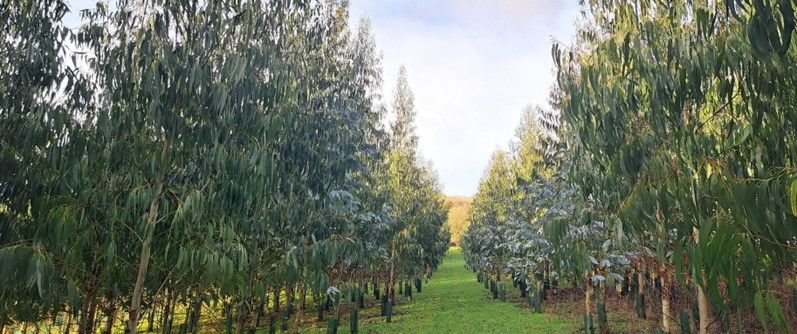 | Mixed Eucalyptus plantation in Devon, UK
(Image courtesy of Eucalyptus Renewables).
| Mixed Eucalyptus plantation in Devon, UK
(Image courtesy of Eucalyptus Renewables).
2. Pre-planting
2.1. Site selection
Suitable soils
Eucalypts can thrive in a variety of soils, including alkaline, acidic, and neutral soils, with a pH range of 4.5 – 7.5. Most species prefer moderately fertile soil with clay content not posing a significant constraint. The diverse native habitats of the Eucalyptus genus have led to adaptability and variation among species in their preferred soil types. For example, Eucalyptus dalrympleana (Mountain white gum) and Eucalyptus coccifera (Snow peppermint, Tasmanian snow gum) grow best on rocky dolerite soils. However, more adaptable species like Eucalyptus glaucescens (Tingiringi gum) can thrive in a broader range of soil types and pH levels. Eucalyptus rodwayi (swamp peppermint/black swamp gum) is remarkably adaptable to sites with poor soil quality due to its low nutrient requirements and extensive rooting ability, making it suitable for land reclamation and as a shelterbelt.
Water availability
In Eucalyptus plantations, water availability is crucial in determining productivity and cellulose production. Typically, Eucalyptus trees can withstand dry and low-nutrient conditions better than many native UK species. However, extended periods of drought can still negatively impact the growth rates of plantations. Therefore, it is advisable to plant most species in well-drained areas. There are exceptions to this general rule. Eucalyptus johnstonii (Tasmanian Yellow Gum) and E. rodwayi are two species that can tolerate waterlogged soil conditions. These species are usually planted in the wettest areas of a selected site. Correctly matching the species to a site's specific constraints is crucial for successful tree establishment and growth.
Temperatrure
There is a wide variation in cold tolerance among different species of Eucalyptus due to their adaptation to specific sites and environmental conditions. Eucalyptus plantation forestry has been successful in many parts of the world, but the cold tolerance of some Eucalyptus spp. has limited their use in temperate zones. However, the oceanic climate in the UK provides more favourable conditions for Eucalyptus plantation forestry. Suitable species for planting in different climatic zones in the UK are sourced from Australian regions with temperate climates that experience cold winters, such as the mountains of Tasmania or the sub-alpine parts of the Great Dividing Range in Victoria and New South Wales. Most of these species have a cold tolerance of -12 to -14°C and can thrive in most sites in the UK. Less frost-hardy species such as Eucalyptus regnans (giant mountain ash) and Eucalyptus delegatensis (Alpine ash) have a cold tolerance of -10°C. They are better suited to the southern climate of the UK, with milder winters and warmer summers. There have also been successful attempts to establish Eucalyptus in Scotland using very cold-tolerant species such as Eucalyptus parvula (Small-leaved gum), which is hardy to -18°C. However, caution should be exercised to avoid planting in frost hollows on susceptible sites.
Photoperiod
The amount of sunlight Eucalypt trees receive during different times of the year is another critical factor that affects their ability to grow and thrive. This is a significant issue when establishing Eucalyptus plantations in northern Scotland. Like other tree species from temperate regions grown in the UK, it's essential to consider the trees' need for plenty of sunlight. Planting Eucalyptus trees with an eastern exposure can help them receive more sunlight in the morning, which is beneficial for their growth. When individual Eucalyptus trees are planted in UK estates and gardens, they are usually placed in a microclimate that imitates a forest environment suitable for these types of structured forest trees.
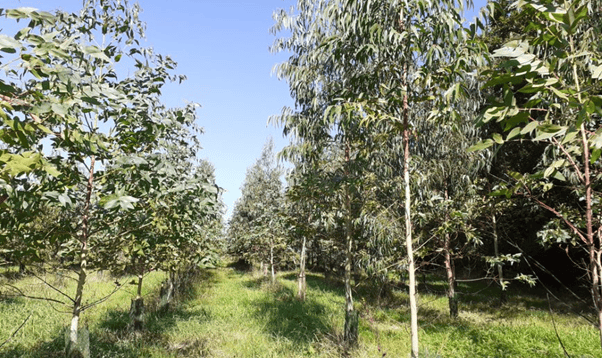 | Eucalyptus nitens plantation in sunny Cornwall (Image courtesy of Eucalyptus Renewables)
| Eucalyptus nitens plantation in sunny Cornwall (Image courtesy of Eucalyptus Renewables)
Site access
The site must allow access by large harvesting machinery and extraction equipment. Slopes exceeding 13% will make it difficult for harvesting machinery, especially in wet conditions, and should be avoided. Overhead power lines pose a risk to anyone near machinery used in site preparation, planting, or extraction. Therefore, a minimum 6m buffer zone with no planting should be maintained underneath the power lines on site.
Suitable land area
The most productive land is the most suitable, as the average yield of various Eucalyptus species is directly correlated to the natural and added site fertility. An economically viable return will be based upon the objectives, with general planting and expected yield matching the owners' biomass requirements. As a viable standalone crop, a minimum size of 5 hectares would be more appropriate. Total thinning timber yields generate around 100 tonnes per 2-yearly thinning cycle before clear-fell rotation at the optimum time, depending on the species regime.
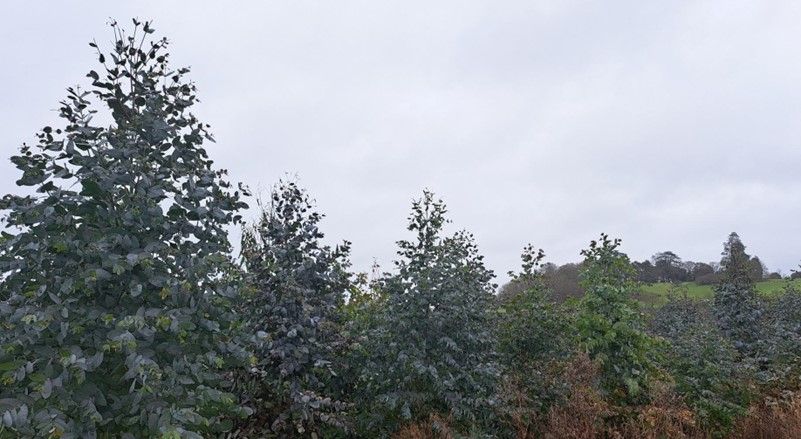 | Eucalyptus within a pastoral landscape (Image courtesy of Eucalyptus Renewables)
| Eucalyptus within a pastoral landscape (Image courtesy of Eucalyptus Renewables)
Location in the landscape
When creating a new woodland, planning and designing it following the UK Forestry Standard is essential. Because Eucalyptus is not native to the UK, extra consideration should be given to how the woodland fits in with the overall landscape and how introducing Eucalyptus trees might impact the local environment and people's ‘sense of place’ for everyday lives. The National and Local Character Assessments offer detailed descriptions of different landscape types in the UK, including historical features, typical land use, flora, fauna, and topographic elements, helping to understand what makes each landscape unique.
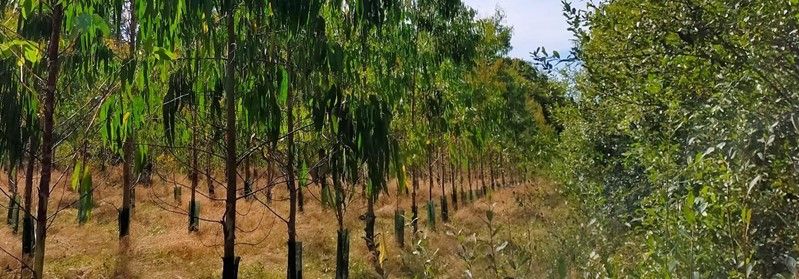 | Eucalyptus growing next to a native hedgerow (Image courtesy of Eucalyptus Renewables).
| Eucalyptus growing next to a native hedgerow (Image courtesy of Eucalyptus Renewables).
2.2. Site preparation
Pre-planting pest control
Eucalyptus trees, especially young ones, do not compete well with weeds. After planting, nearby vegetation, particularly grasses, can harm the trees' early growth. These grasses extract the nutrients from the soil the trees need to grow whilst also competing for water. It's crucial to initially control the vegetation at the planting site, targeting the grass to help the Eucalyptus plugs grow successfully. A herbicide like glyphosate (360 g/l product at 5-6 l/ha) should be used to control the growing vegetation in September or early spring. Allowing enough time for effective control is essential for sites with heavy vegetation like bracken. It's crucial to seek local expertise for the best practices in managing vegetation control.
Soil testing & managment
It's essential to conduct soil testing before planting. The pH, Soil Nitrogen Supply (SNS), phosphorous (P), potassium (K), and magnesium (Mg) should be checked and adjusted during site preparation if necessary. Various soil testing companies provide comprehensive soil analysis and reporting, including field-level analyses for targeted nutrient application. Based on the soil test results, nutrient or lime application may be necessary to optimise conditions for Eucalyptus. However, unnecessary fertiliser application should be avoided, as it may encourage weed competition during establishment. In addition to traditional soil testing, soil microbial biomass and community profiling can be valuable. As aforementioned, mycorrhizal fungi are imperative to the successful establishment of Eucalypts, and testing for mycorrhizal fungi levels in the soil can determine if supplements are needed for planting. Baseline soil analysis is also helpful for identifying soil carbon stores. To find out more visit the link below: https://ahdb.org.uk/knowledge-library/soil-and-forage-testing-companies
Ploughing, mounding & sub-soiling
Shallow ploughing is the preferred method for establishing new woodlands due to its cost-effectiveness, speed, and weed suppression benefits. However, this method is only suitable for creating new woodlands, as ploughing through existing root structures and stumps from previous trees would be challenging. For instance, when transitioning from arable or grassland to woodland. If ploughing is not feasible, the land should be mounded to create a clear planting area. Sub-soiling or ripping to a maximum depth of 25cm will significantly improve establishment by increasing the air volume within the soil to prevent compaction, enabling lateral root spread and taproot development. This is important for providing structural support to the trees. The root systems in young trees exhibit high mycorrhizal fungal activity, which aids in their establishment and initial growth. While replanted woodlands generally have sufficient fungi, mycorrhizal supplementation is vital for new tree planting in grassland and arable sites to aid in tree establishment.
Excluding vertebrate herbivores
The specifications for a site can vary greatly depending on the type of Eucalyptus trees being planted. While most Eucalyptus trees are less likely to be eaten by animals compared to many native broadleaved species, it is recommended to install fencing in areas where there is heavy browsing by deer, rabbits, or hares. If fencing or netting is needed due to heavy browsing, it should be installed before planting. For areas with rabbits or hares, a minimum netting height of 1.05m with an 18-gauge x 31 mm hexagonal mesh should be used, with the bottom of the netting buried and turfed. Depending on the type of deer in the area, a minimum fence height of 1.5-1.8m should be considered, with mesh sizes ranging from 80 mm x 80 mm for muntjac to 300 mm x 220 mm for red or sika deer. The use of fencing or netting will significantly increase the overall cost of site preparation. Therefore, to minimise the need for fencing, it is advisable to choose Eucalyptus species that are less palatable and require less protection from browsing and bark stripping.
2.3. Species selection
The following text lists various Eucalyptus detailing their typical characteristics, preferred growing conditions and tolerances. This information will help determine the best species selection based on end use and planting location.
Eucalyptus aggregate (Black Gum)
- Cold tolerant to -14°C
- Fine narrow leaves - looks like UK broadleaf trees
- NSW mainland only, cold areas, not shade tolerant
- Related to E.ovata, Tasmanian Black swamp gum
- Poorly drained upland areas, frost hollows to 800m above sea level
- Creates extensive horizontal rooting structures
- Used extensively as part component of shelterbelts
- To 20m height
- Growth 24m3/ha/yr
- Plant in wettest of the planting area
Eucalyptus coccifera(Tasmanian snow gum)
- Cold tolerant, frost hardy to -16°C
- Naturally grows in Tasmania on mountains to 1300m asl (above sea level)
- Grows on well drained, rocky dolerite soils
- Cope with conditions of frost, snow and wind
- Juvenile leaves round and glaucous
- Successful establishment in Scotland
- Straight vigorous tree
- Up to 40m in height
- Plant on exposed site
Eucalyptus dalrympleana (Mountain white gum)
- Cold tolerant to -14°C
- Well-drained upland sites to 900m above sea level
- Excellent apical dominance characteristics
- Potentially one of the best suited species to UK conditions
- Prefers a slightly acidic soil but will tolerate most soil types
- Quality timber, to 50m height
- Growth 30m3/ha/yr
Eucalyptus delegatensis subsp. tasmaniensis (Gum-topped stringybark)
- Part of the blue ashes group
- Similar habitat to dalrympleana, often on dolerite
- 400-900m asl provenance plateau range
- Establishes well within a sheltered forest microclimate
- Cold tolerance to -10°C
- More fertile well drained sites, large juvenile leaves, plant on most protected sites generally sheltered by other forest trees within natural habitat
- Req. tree guards to maintain stability over initial establishment period
- To 90m height, substantial high timber quality
- Growth 38m3/ha/yr
Eucalyptus denticulate (Errinundra shining gum)
- As nitens, narrow juvenile leaves, higher 600m asl provenance
- Cold tolerance to -12°C, establishes quicker than nitens
- Req. well drained sites, large juvenile leaves
- Req. tree guards to maintain stability over initial establishment period
- To 70m height
- Growth 38m3/ha/yr
E. glaucescens (Tingiringi gum)
- Cold tolerant to around -18°C
- To 1400m asl
- Adaptability to sites
- Series of control provenances
- Range 20 to 40m height
- Growth 26m3/ha/yr
- Plant through majority of area some drainage required
- Will thrive throughout most sites in UK
Eucalyptus globulus ssp.bicostata (Southern blue gum)
- Excellent for shade and shelter
- Range 50-800m asl, saline tolerant
- Establishes well within a sheltered forest microclimate.
- Cold tolerance to -8°C
- Competitive for near-surface soil moisture
- Thrives on well drained clay-loam sites
- Large juvenile sessile leaves, dull, greyish and waxy
- Plant on most protected sites generally sheltered by other forest trees within natural habitat
- Req. tree guards to maintain stability over initial establishment period
- To 90m height, substantial high timber quality
- Dense timber 900kg/m3, suitable for general construction/biomass
- Growth 40m3/ha/yr
- Very rapid growth, on the right climatically protected site, of 50m3/ha/yr in UK
 | Eucalyptus globulus ssp. bicostata (Image courtesy of Eucalyptus Renewables)
| Eucalyptus globulus ssp. bicostata (Image courtesy of Eucalyptus Renewables)
Eucalyptus johnstonii (Tasmanian Yellow Gum)
- Related to E.subcrenulata,
- Tasmanian Alpine Yellow Gum (subalpine spp.)
- Plant in wettest of the planting area Recommended use in mild coastal areas
- Cold tolerant to around -12°C
- Range 500 to 800m asl
- Tall forest tree in sheltered valleys Good apical dominance characteristics
- Juvenile leaves are egg-shaped to almost round
- Tolerant of waterlogged thin peaty soil conditions
- Grows best on deep clay loams in valleys and sheltered sites.
- Less tolerant than other Eucalypts of sustained drought conditions
- Can be damaged by prolonged dry periods
- Rapid early growth
- Height range 20 to 50m height
- Growth 26m3/ha/yr
Eucalyptus nitens (Shining gum)
- Cold tolerant to around -10°C
- Requires well drained sites, large juvenile leaves
- Requires tree guards to maintain stability over initial establishment period
- To 70m height in natural environment
- Best short rotation cold tolerant species
- Growth 40m3/ha/yr
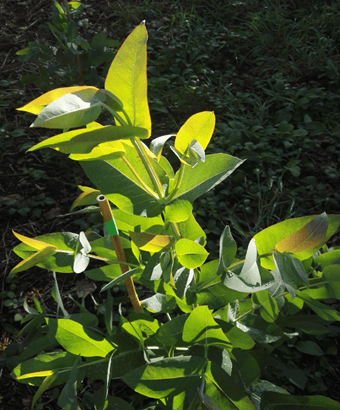 | Young Eucalyptus nitens (Image courtesy of Eucalyptus Renewables)
| Young Eucalyptus nitens (Image courtesy of Eucalyptus Renewables)
Eucalyptus parvula (Small leaved gum)
- Cold tolerant, very frost hardy to -18°C
- Naturally grows in poorly drained, waterlogged soils
- Cope with conditions of frost, snow, wind and heavy mist
- Successful establishment in Scotland
- Up to 15m in height
- Plant in most exposed site
- Shelterbelt potential mixed with other species to encourage an improved microclimate
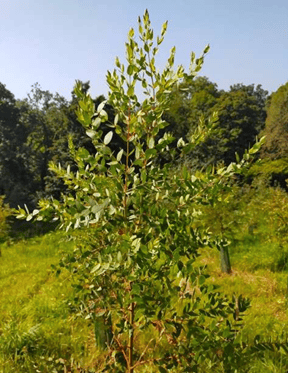 | Eucalyptus parvula (Image courtesy of Eucalyptus Renewables)
| Eucalyptus parvula (Image courtesy of Eucalyptus Renewables)
Eucalyptus regnans (giant mountain ash)
- Part of the ashes group
- Range 200-500m asl
- Establishes well within a sheltered forest microclimate
- Cold tolerance to -10°C,
- Thrives on fertile well drained sites,
- Large juvenile glossy green leaves,
- Plant on most protected sites
- Generally sheltered by other forest trees within natural habitat
- Req. tree guards to maintain stability over initial establishment period
- To 90m height, substantial high timber quality, marketed as Tasmanian Oak
- Growth 38m3/ha/yr
Eucalyptus rodwayi (Peppermint Swamp Gum)
- Cold tolerant to -12°C
- Fine narrow leaved (looks like UK broadleaf trees)
- Poorly drained upland areas, frost hollows to 800m asl
- Creates extensive horizontal rooting structures
- Used throughout the world as a specialised landfill pioneer species
- To 30m height
- Growth 26m3/ha/yr
- Plant in wettest of the planting area
E.subcrenulata (Tasmanian Alpine yellow gum)
- Cold tolerant to around -14°C
- Related to E.johnstonii (500-800m asl)
- To 1100m asl
- Tall forest tree in sheltered valleys
- Wet tolerant soil conditions
- Range 20 to 50m height
- Growth 26m3/ha/yr
_Eucalyptus pauciflora subsp. debeuzevillei _(Jounama snow gum)/_E.parvula _
- Cold tolerant, very frost hardy to -18°C
- Naturally grows in well drained on sandy, rocky soils
- Cope with conditions of frost, snow, wind, and heavy mist Tolerant of saline and salt spray conditions
- Successful establishment in Scotland
- Juvenile foliage utilised extensively in the foliage industry
- Up to 15m in height
- Plant in most exposed site
- Shelterbelt potential mixed with other species to encourage an improved microclimate
Eucalyptus urnigera (Urn gum)
- Cold tolerant, very frost hardy to -18°C
- Naturally grows in Tasmania on mountains and plateaux (to 1000m asl)
- Grows on well drained, rocky dolerite soils
- Cope with conditions of frost, snow, and wind
- Tasmanian equivalent to E.glaucecscens
- Successful establishment in Scotland
- Up to 15m in height
- Plant in most exposed site
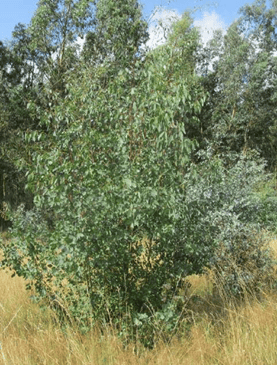 | Eucalyptus urnigera (Image courtesy of Eucalyptus Renewables)
| Eucalyptus urnigera (Image courtesy of Eucalyptus Renewables)
Eucalyptus gunnii (Cider gum)
- Cold tolerant, very frost hardy to -18°C
- Naturally grows in poorly drained, basalt type soils
- Copes with conditions of frost, snow, wind, and heavy mist
- Successful establishment in UK Up to 25m in height
- Plant in most exposed site
- Tolerant of saline and salt spray conditions
- Juvenile leaves round and glaucous, suitable for foliage
- Coppices well up to the age of 15
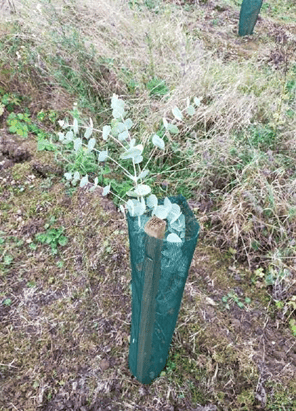 | Young Eucalyptus gunnii (Image courtesy of Eucalyptus Renewables)
| Young Eucalyptus gunnii (Image courtesy of Eucalyptus Renewables)
List of suppliers
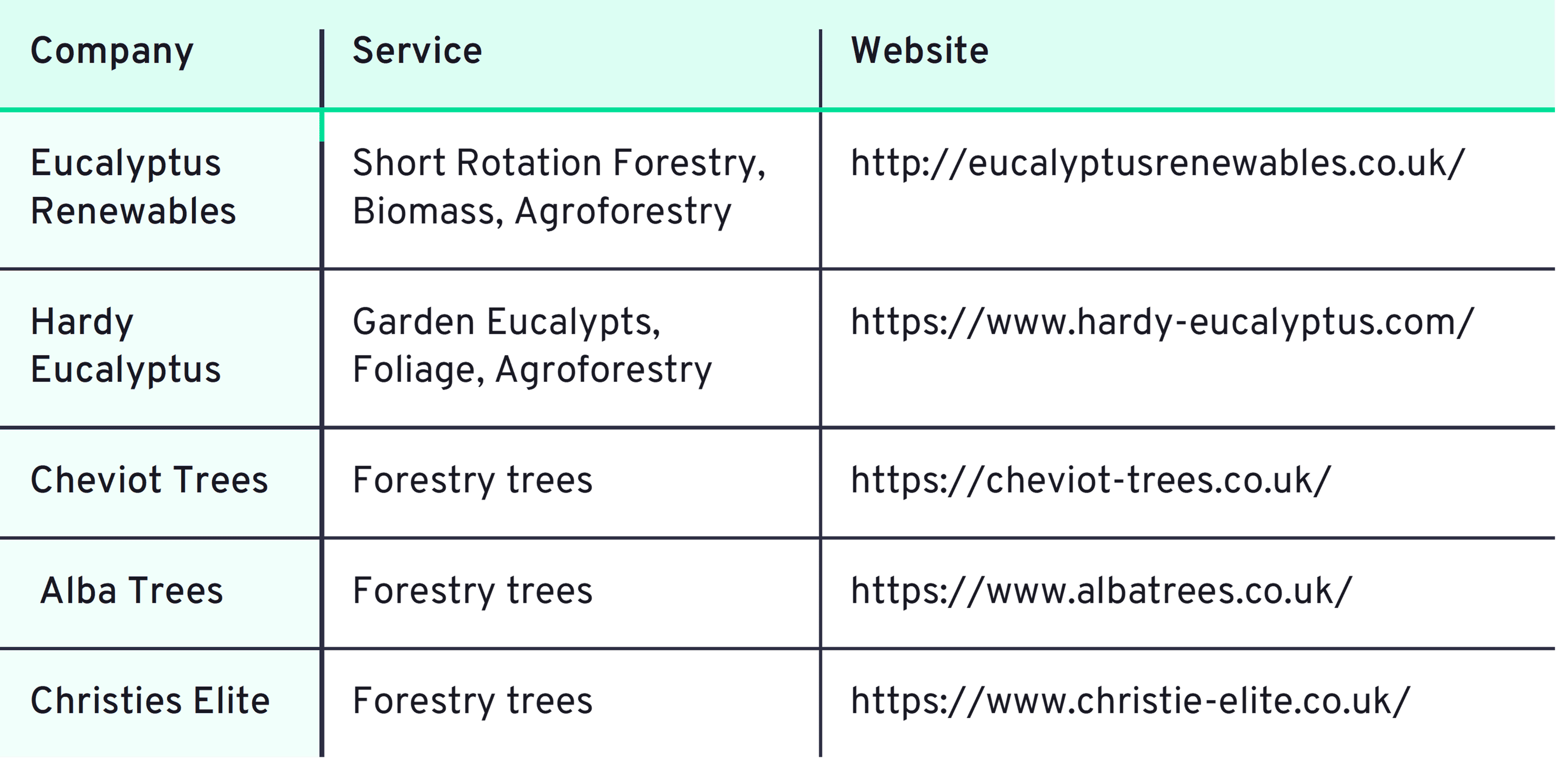
2.4. Planting material
Planting plugs
Plug plants are 10-20 cm high seedlings grown in trays of small cells. They can be planted directly in the ground. Usually, there are 100 plug plants in a tray.
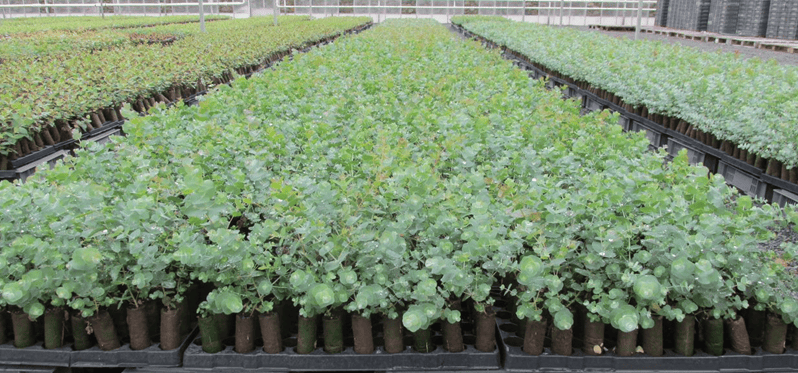 | Eucalyptus nitens plaugs (Image courtesy of Eucalyptus Renewables)
| Eucalyptus nitens plaugs (Image courtesy of Eucalyptus Renewables)
Planitng mixtures
It is essential to plant mixtures of varieties and cultivars in short-rotation forestry to establish genotypic diversity and reduce disease susceptibility. The more diverse a plantation is, the less susceptible it will be to rust and other diseases. This practice is not currently used for Eucalyptus, but it is recommended due to the significant threat that diseases pose to plantations. As the use of biomass crops increases, disease pressure is likely to rise, exacerbated by climate change expanding the ranges of pathogens. Mixed plantations not only help mitigate disease damage but also enhance plantation production and yields despite the limited literature supporting this for Eucalyptus. Furthermore, mixed plantations offer more significant environmental and ecological benefits than monoclonal plantations. Therefore, increasing genotypic diversity in plantations is crucial to ensure the long-term resilience of cropping systems.
Plant breeder's rights
Plant breeders' rights protect new varieties of plants and grant intellectual property rights to new plant varieties. In the UK, these rights are known as plant breeders' rights, while in the EU, there is a system called Community plant variety rights. Both of these systems comply with the regulations of the International Union for the Protection of New Varieties of Plants (UPOV). Similar systems are established in 70 countries worldwide under the UPOV. New Eucalyptus varieties are protected under plant breeders' rights, meaning certain activities are prohibited or can only be carried out under contract with the plant breeder.
It is always worth being aware of the plant breeders’ rights for the variety you want to grow.

Planting machinery
Specialist forestry planting machinery can be used, but they are generally only possible to justify if the planting numbers are in the tens of thousands. Planting machinery uses potato planting trailers towed by a tractor with a plough to create a planting slot. The plugs are then dropped in by hand at measured intervals, and double wheels are used to pack the soil around the plugs. However, specific planting operations are usually done by hand to ensure that the trees are planted more carefully and that the roots are firmly secured in the soil.
3. Planting
When planting Eucalyptus trees, it is recommended to use rip lines with sprayed-out or biodegradable mulch mats (30-45 cm centres) to improve the initial development of the trees’ white root establishment. A wide net tree guard and stake/cane can help encourage upright growth and stable root development. Eucalyptus trees have a strong adaptive apical tendency, prioritising the leading apical bud over lateral buds. Additionally, tree guards can help prevent rabbit browsing.
The main goal when establishing Eucalyptus trees is to achieve canopy closure as quickly as possible to create a suitable forestry microclimate. To aid in this, using biodegradable mulch mats at the base of each tree can help with weed control, eliminating competition for nutrients in the soil and water. However, if proper pre-planting operations and timely weeding interventions are carried out, guards and mulch mats may not be necessary.
Weed control is crucial for the first two years of growth until canopy closure is achieved, especially on previously grassed sites. It's worth noting that on forestry cutover sites, Eucalyptus trees are generally successful as they tap into available mycorrhizal fungal activity and effectively compete against other types of weed competition. In a forestry situation, the impact of "no-spray" interventions is much less significant than on previously grassed sites, as Eucalyptus trees generally outcompete other weed types.
 | Eucalyptus planting with rip lines (Image courtesy of Eucalyptus Renewables)
| Eucalyptus planting with rip lines (Image courtesy of Eucalyptus Renewables)
3.1. Timing
It is advisable to plant in spring using plugs after the last frosts of the new year to ensure good establishment. This encourages the longest growing opportunity over the summer and autumn before light and temperature impact growth rates.
3.2. Planting density
When initially planting, the spacing between plants should be up to 2 x 2 meters, which amounts to 2500 stems per hectare. This spacing is recommended for maximising biomass (cellulose) production. It's important to consider that as the trees grow, they will start competing for light and space, which will become a significant factor when planning thinning interventions starting from around four years of age. Unlike other tree species, the primary factor in determining these trees' initial spacing and interventions should be the product objectives, as they have a more immediate growth response.
3.3. Planting depth
When planting forest trees, planting them below the root collar is essential. Bareroot trees should be planted deep, slightly firmed up, and then given a slight pull-up to straighten the root framework before properly firming the ground.
For Eucalyptus plugs, it is essential to plant the plug entirely beneath the soil surface. If the plug is above the ground, it can lead to moisture and nutrient loss, making the tree vulnerable to drought in spring and summer. Firming the soil above the plug creates an effective seal, enhancing survival against climatic events and protecting the roots.
 | Eucalyptus planting at 2 x 2m (Image courtesy of Eucalyptus Renewables).
| Eucalyptus planting at 2 x 2m (Image courtesy of Eucalyptus Renewables).
4. Post-planting establishment
4.1. Nutrition & fertilisaiton
Soil nutrition is generally only crucial for first-rotation crops on afforestation sites if the soil is impoverished or requires restocking. Eucalyptus trees respond well to balanced NPK fertilisers, which can boost their productivity. Fertilisers are most effective during the early stages of growth, as their impact tends to decrease after the second year when the trees have reached their maximum nutrient requirements.
During the initial growth period of about two years, Eucalyptus trees have high nutrient requirements, particularly for N, P, and Ca. After this initial period, the requirements for these nutrients remain relatively stable, while the need for potassium and magnesium decreases slightly. The trees become self-sufficient at this stage, typically when the canopy is fully formed.
For sites that require additional nutrition, such as restocking areas, a single application of fertiliser at the time of planting is adequate to establish the crop. Restocking Eucalyptus plantations needs to produce large amounts of biomass in soils with low fertility; therefore, it's essential to maintain soil fertility over successive rotations to optimise silvicultural practices.
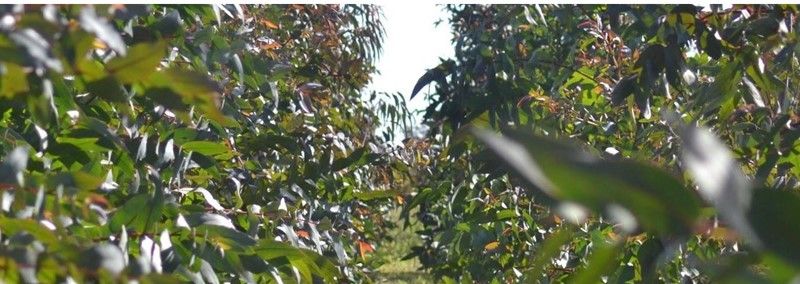 | Eucalyptus nitens close to canopy closure (Image courtesy of Wildwood Fuel)
| Eucalyptus nitens close to canopy closure (Image courtesy of Wildwood Fuel)
4.2. Weed control
When planting trees on previously grassed sites, it's essential to spray the area to reduce weed competition and ensure the trees can grow well initially. This is especially necessary for the fast-growing eucalyptus trees and should be done for the first two years after planting. This will require 2-3 applications of herbicide. After this time, the trees will have grown enough to outcompete the weeds for sunlight, water, and nutrients.
Spot spraying is the best method for weed control, as it's cost-effective and environmentally friendly. A certified professional contractor should carry out the spraying in accordance with the Control of Pesticides Regulations 1986 (COPR). The recommended approach is to spray a 1m x 1m square around the tree using an herbicide such as glyphosate. This minimises costs and limits environmental damage by reducing herbicide use.
Herbicide use should be carefully considered when creating a forest management plan. There are instances where the application of herbicide may not be beneficial. For example, studies have shown that grass interference can cause losses of up to 50% in eucalypt yield and reduce the profitability of forestry enterprises located on prior pastoral land by over 90%. However, "no-spray" intervention management schemes on forestry clearcut sites have shown little to no effect on total yield production.
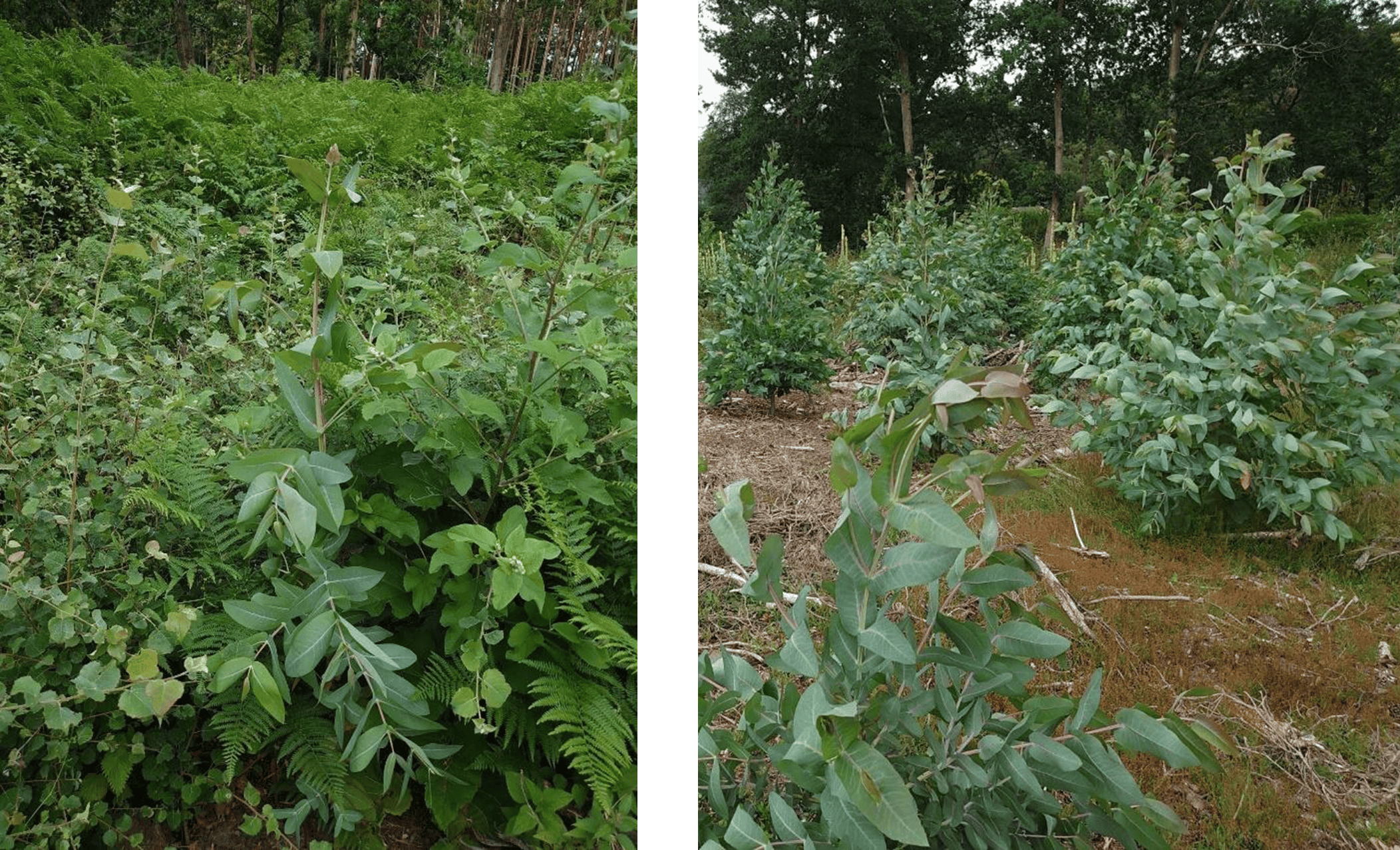 | Young Eucalypts. Left shows weed competition from an unsprayed site. Right shows managed healthy trees (Image courtesy of Eucalyptus Renewables)
| Young Eucalypts. Left shows weed competition from an unsprayed site. Right shows managed healthy trees (Image courtesy of Eucalyptus Renewables)
4.3. Disease & pests
Eucalypts in the UK have been relatively free of pests and diseases. However, southern Europe has experienced the emergence of some serious insect pests. Stringent biocontrol measures are proving to be effective in slowing the spread. Additionally, the UK's cooler climate may reduce the impact of these pests if they do reach our shores, as it's unlikely that the UK would have extensive plantings to facilitate their spread and survival.
Nevertheless, if we plant these trees, we are responsible for monitoring for emergent pests and diseases. Some of the insect pests observed in Europe include the red gum lerp psyllid (Glycaspis brimblecombei), bronze bug (Thaumastocoris peregrinus), gall wasps (Leptocybe invasa), leaf-feeding beetle (Gonipterus scutellatus), two closely related species of longhorn beetles (Phoracantha semipunctata and P. recurve), and gypsy moths (Lymantria dispar).
Fungal pathogens, considered the most significant threat to Eucalyptus plantations in Europe, have been observed and isolated from trees in southern Europe. Fungal diseases such as leaf spot (Mycosphaerella spp.) and stem cankers have been observed on Eucalyptus trees in Spain. If not carefully monitored, these fungal diseases have the potential to become devastating.
Eucalypts appear generally unaffected by grey squirrels or voles, and deer also show little interest. However, deer fraying can target individual trees, especially if there are no alternative browsing opportunities available.
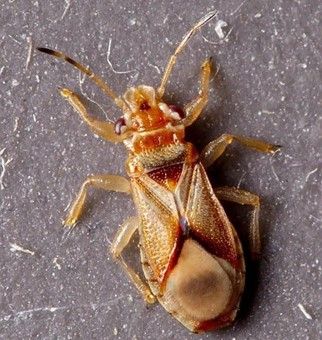 | Thaumastocoris peregrinus - Bronze bug pest of Eucalyptus (Image courtesy of Junkyardsparkle)
| Eucalyptus nitens close to canopy closure (Image courtesy of Junkyardsparkle)
| Thaumastocoris peregrinus - Bronze bug pest of Eucalyptus (Image courtesy of Junkyardsparkle)
| Eucalyptus nitens close to canopy closure (Image courtesy of Junkyardsparkle)
5. Harvesting
Timber harvest thinning operations are suitable for shortwood systems and generally do not significantly differ from established UK harvesting systems. Shortwood harvesting is less impactful on sites with stump branches and slash left on skid trails, protecting the soil and roots. It will be more important to use more aggressive rotating harvesting heads as there is a need to cut up and accelerate bark removal from harvested round wood with Eucalypts. Juvenile trees will typically discard any contaminants in the bark, which tends to be relatively fibrous and of low calorific value.
5.1. Timing
There are no specific physiological parameters to determine the best time for timber harvesting. The decision-making process is generally based on when the mean annual increment falls below the average annual increment, indicating growth slowing. There are many factors in this process, such as:
- Species
- Climatic events
- Owner objectives
- Silvicultural regimes
- Thinning interventions
- Weeding regimes
- Timber Price optimising
- Availability of machinery/labour
- Minimising extraction damage - winter harvesting
5.2. Harvesting methods & machinery
Conventional timber harvesting machinery operations are effective, relatively inexpensive, and offer cost benefits. Forestry harvesting techniques for tree thinning entail removing rows in a specific pattern and some intermediates between the rows. The impact on the existing crop is a critical consideration in determining the intensity of the thinning intervention. It is advisable to consult a specialist about this. The basic idea is to reduce the effect of competition for canopy space. This approach relies on contractors, machinery, and labour availability.
- Tractor and timber trailer for forwarding or purpose-built forwarder, dependent on the scale.
- Felling with chainsaws or a timber harvesting machine with a harvesting head.
- A stacking area is required to store cut material until enough volume has been accrued for a timber lorry to enter the loading bay and transport.
- Markets need to be organised for various timber products, and the operation is structured with the certainty of supply to meet an agreed expected delivered volume.
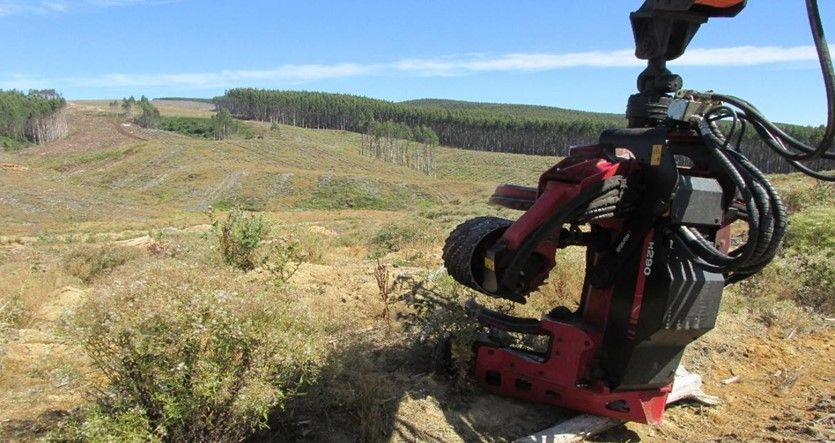 | Rotating forestry harvesting head (Image courtesy of Eucalyptus Renewables)
| Rotating forestry harvesting head (Image courtesy of Eucalyptus Renewables)
6. Post-harvest
6.1. Yield
Eucalyptus species can produce wood at a high annual yield, which is not seen in traditional forestry. Basic summary:
- Eucalypts have the potential to produce world-class growth rates of over
- 40 m3/ha/annum.
- The trees have a high basic wood density.
- Stocking density at 2000 stems/ha.
- Production thinning starts at age four, with thinning cycles every two years.
Eucalypts do not have a true dormant period and retain foliage, enabling growth during warm winter periods. As a result, Eucalyptus yields are significantly higher than those of traditional forestry. Yields will vary greatly depending on the species of Eucalyptus planted to suit climatic conditions and specific site characteristics. E. glaucescens has been successfully established throughout drier East Coast locations in Wales, Midlands, and Scotland, with annual yields in the region of 25 m3/ha/annum. In southern Britain, E. nitens and E. denticulata are similar species well-suited to temperate climates with cool, wet winters. These two species can achieve world-class growth rates of over 40 m3/ha/annum with reasonable planting procedures and timed spraying interventions. The basic wood density for juvenile sapwood is 480 to 530 kg/m3, with mature heartwood developing up to 800 kg/m3. The wood cell structure and parameters are similar to those of English oak. Permanent Sample Plots planted in 2014 on the award-winning Treworder Plantation in Cornwall show more than 40 m3/ha/annum yields. In September 2017, the average tree height was 10.1 m, and the average DBH was 10.2 cm at 40 months. With a stocking density of 2000 stems/ha, canopy closure was achieved at around 18 months. From the 8 initial hectares of E. nitens planted at 2000 stems/ha, the growth was recorded at 2-3 m per year with a PSP yield of 46 m3/ha/yr. Production thinning was started at age four, and felling licences were in place. Thinning cycles occur approximately every two years, historically removing between 20 to 40 m3 in each silvicultural intervention.
6.2. Drying & storage
The success of biomass feedstock depends on achieving a low moisture content during post-harvest handling and storage. Drying is a crucial process that allows moisture to be removed through desorption and evaporation, resulting in higher heat output and fewer emissions when the end product is burned. In any form of biomass storage, there are three key basic principles:
- To ensure ventilation
- To expose the largest surface area
- Minimise the additional ingress of water
The following methods can be used to dry firewood: passive or active drying methods, such as assisted airflow mechanisms like fans, flue gases, and air heating from a boiler or solar heat exchanger. Eucalyptus firewood can be seasoned in an open log store, protected from the elements. Elevating the material off the ground within a structure is important to help with airflow. While outdoor seasoning is the cheapest method, requiring little additional equipment, it is the slowest and least effective at reducing moisture content. For a faster drying process with lower moisture content, consider kiln drying, which can be fuelled by biomass from harvest by-products, making the firewood production carbon neutral. Active dried chip storage can minimise the need for large drying timber stores. Chipped material should be stored in piles below 50 ft or, if containing bark and foliage, 25 ft high. Pile temperature should be routinely monitored. To prevent layering, sawdust, shavings, and chip fines should not be mixed into the stored material.
Drying Eucalyptus
Eucalyptus wood should be split before it is left to season, as its fibres tend to twist during the drying process, making it difficult to split afterwards. After harvesting, the logs should be stacked and left for a short period to release some oil and moisture, but they should be cut within two weeks.
The time it takes to air dry cut Eucalyptus logs outdoors can vary depending on factors such as the wood species, dimensions, weather conditions, and the time of year the logs are stacked. Due to its moisture content, Eucalyptus wood can take 18-24 months to dry. Green Eucalyptus has a high oil content, which affects the drying time, but its sap content is low, making it suitable for burning. Unseasoned wood with more than 20 percent moisture content should not be burned indoors, as it can produce smoke and creosotes.
Kiln drying, however, can reduce the moisture content to less than 20 percent in 1-6 weeks, depending on the kiln's efficiency and the size of the wood product. Eucalyptus can dry in 6-10 days in a kiln at 60-70°C, producing a cleaner burn and maximum heat output. However, kiln-drying involves high start-up and energy costs. The three most common types of kilns are conventional, dehumidification, and vacuum. Prices for small-scale conventional kilns start at around £5000.
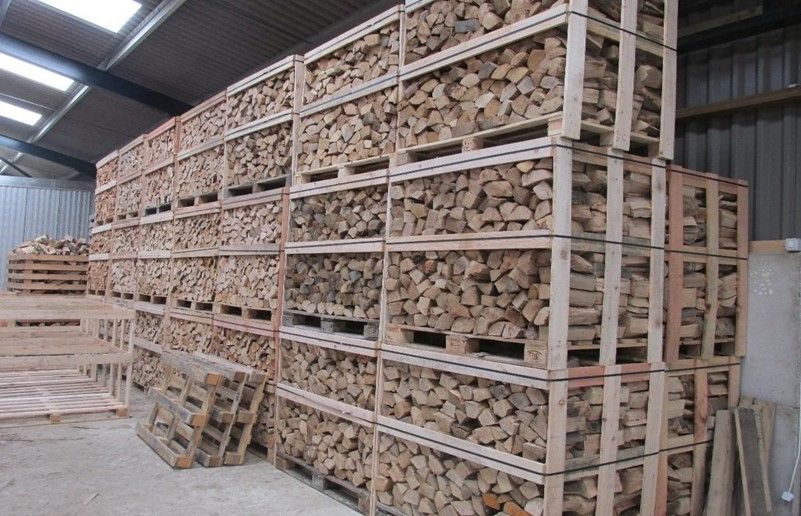 | Eucalyptus wood store (Image courtesy of Wildwood Fuel)
| Eucalyptus wood store (Image courtesy of Wildwood Fuel)
6.3. Transportation
In shortwood harvesting, trees are fully processed at the felling site. Once the trees are felled, they are stripped of limbs and cut into various product specifications. The logs are then transported to a separate processing and storage site where they will be allowed to dry. This process involves two stages of transportation: first, on-site transport, followed by off-site transport.
On-site transportation
Logs are transported from the woodland interior to the landing, where primary processing can take place. Skidders or forwarders carry the logs along skid trails, set up as temporary unimproved roadways. Once sorted, delimbed, and cut, the logs are loaded from the landing onto trucks.
Off-site transportation
Hiring a professional timber road haulage company to transport the timber to the desired secondary processing location is important. This may involve following an agreed route for responsible road and traffic management, as set out by a local governing body in parts of Northern England, Wales, and Scotland. These regulations can affect delivery time and pricing.
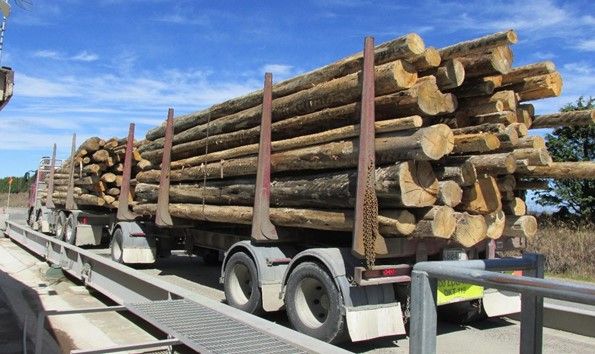 | Timber haulage from forestry site (Image courtesy of Eucalyptus Renewables).
| Timber haulage from forestry site (Image courtesy of Eucalyptus Renewables).
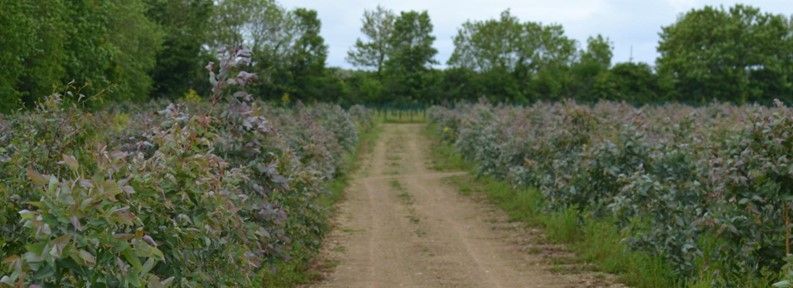 | Access track through Eucalyptus plantation, Cornwall, UK (Image courtesy of Wildwood Fuel)
| Access track through Eucalyptus plantation, Cornwall, UK (Image courtesy of Wildwood Fuel)
6.4. Site restoration
Clearance
After shortwood harvesting, tree stumps are cleared using an excavator and forwarder combination. The product can be mulched topsoil strip or removed from the site for further use as biomass chip. Stump harvesting is generally carried out using an excavator and forwarder combination. Excavators are equipped with either a static rake attachment or a splitter-puller attachment. Stumps are uprooted, split, and shaken to remove soil. Stumps are then piled for later extraction by the forwarder. The cost of stump harvesting in the UK is in the region of £21.00–£29.00 (£6.00–8.50/tonne (green) to uproot, £3.00–8.50/tonne (green) to extract, and £12.00/tonne (green) to transport to the point of use). This efficient method maximises the amount of side root removal and ensures that following ground preparation measures can occur unhindered.
Reinstatement
After clearing the land, it can be mounded and sub-soiled, ready for restocking. On good-quality restock sites where weeds are not present at planting and plenty of natural mulch is available, eucalypts may be established sufficiently and rapidly, and post-planting weed control is not necessary for good crop establishment. However, post-planting weed control could still be beneficial. If weed control is not done effectively in the months after planting, it can lead to poor tree establishment, slow growth, and low survival rates.
7. Advantages & disadvantages
7.1. Advantages
- Fast growth: Eucalyptus trees are known for their rapid growth, which means they can produce a lot of biomass in a relatively short amount of time.
- High yield: Eucalyptus trees have a higher biomass yield per hectare than other tree species commonly grown in the UK.
- Drought tolerance: Eucalyptus trees are relatively drought-tolerant, which could be advantageous in areas with low rainfall.
- Low maintenance: Eucalyptus trees require relatively low maintenance levels, which can reduce the cost of production.
- Multiple uses: Eucalyptus can be used for various products, including timber, paper, essential oils, and bioenergy.
7.2. Disadvantages
- Non-native species: Eucalyptus is not native to the UK and may not be well-adapted to local conditions. Introducing a non-native species could also have unintended ecological consequences.
- Risk of invasive species: Eucalyptus has been known to be invasive in some regions, and there is a risk that it could become invasive in the UK, potentially outcompeting native species and reducing biodiversity.
- Frost-sensitive: Eucalyptus trees are sensitive to frost, which could limit their ability to grow in colder parts of the UK.
- Water use: Eucalyptus trees require a lot of water, which could be a concern in areas with limited water resources.
- Soil quality: Eucalyptus trees have been shown to reduce soil quality over time, which could limit their long-term sustainability as a biomass crop.
- It's worth noting that the advantages and disadvantages will vary depending on the variety selected, the specific location and the context of the Eucalyptus plantation.
8. Legislation
8.1. Environmental impact assessment
A Two Stage Approach:
- A SRF proposed plantation within the UK over 0.5 hectares will require an Environmental Impact Assessment (EIA). Applicants must submit an Afforestation Stage 1 EIA wherein the Forestry Commission will decide if the project has the potential to cause significant impact upon the environment. Where proposed sites are decided not to have significant impact by the Forestry Commission the project will not require further consent to proceed.
- Where projects are judged to meet the threshold which may cause a significant impact upon the environment, applicants must continue to Stage 2 of the EIA process. For this stage the application process will need to include an Environmental Statement and project scoping in addition to a more detailed project proposal.
Please see this guidance document for more information: www.gov.uk/guidance/environmental-impact-assessments-for-woodland
Cases which will not require an EIA as stated by the UK Government:
- Applications for a woodland creation grant that is administered in whole or in part by the Forestry Commission are advised not to submit a ‘stage 1’ EIA application.
- If the proposal is development-related (i.e. requiring planning permission) then it will normally be screened by the local planning authority under the Town and Country Planning (Environmental Impact Assessment) Regulations 2017, and as such will not require an EIA.
- A proposed afforestation site under 0.5 hectares does not require an EIA (unless located adjacent to another afforestation project completed within the last five years or on sensitive land).
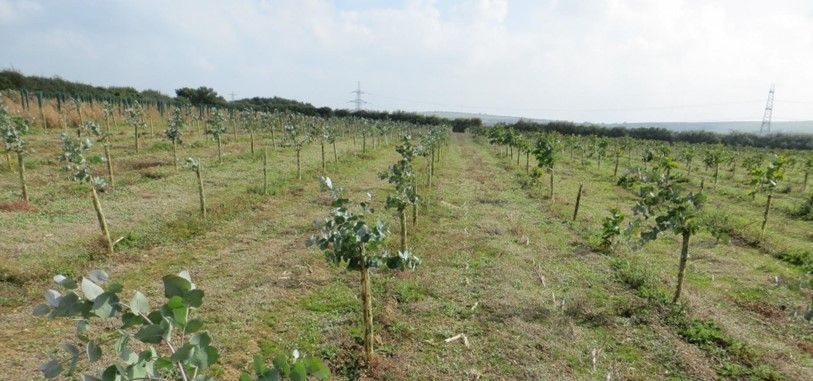 | 2-Year-old Eucalyptus plantation (Image courtesy of Eucalyptus Renewables)
| 2-Year-old Eucalyptus plantation (Image courtesy of Eucalyptus Renewables)
Discalimer
Throughout this publication, references are made to several pesticides (herbicides, fungicides, and insecticides) that have been used either commercially or experimentally in Eucalyptus production. It should be emphasised that with any pesticide application, the relevant legislation (Health and Safety at Work Act 1974; Poisonous Substances in Agriculture Regulations 1984; Food and Environment Protection Act 1985; Control of Pesticides Regulations 1986; Control of Pollution Act 1974; Plant Protection Products (Sustainable Use) Regulations 2012 etc.) and the Product Label Recommendations must be adhered to.